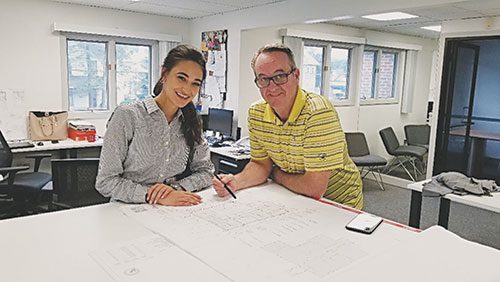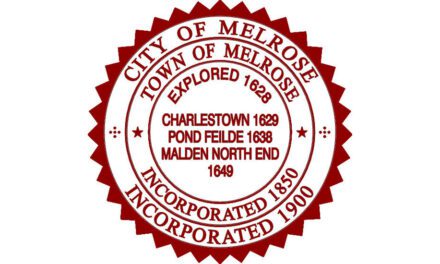Published August 23, 2019
This is another in a series of “Around Town” articles that highlight various people and businesses in Melrose.
MELROSE — Melrose will soon have its first passive sustainable house, designed and built by local architect Jay Bradley. Assisting Bradley on the project is Diana Matei of Cluj, Transylvania, Romania. A recent graduate with a masters degree in Architecture from the Technical University of Cluj, Matei secured an internship to work for Bradley on his most recent project in town. The Weekly News caught up with Matej and Bradley to discuss her role in the project, her 4,365 mile odyssey which brought her to Melrose and the project which has Melrose buzzing with excitement.
Do you get a lot of jokes from Americans about being from Transylvania?
Diana: It’s kind of funny because when I first arrived here it was on …. Halloween. That was my first day here. The kids were coming and they were asking Jay, “so who’s this?” and he was telling them this is my new intern and she’s from Transylvania. And the kids are like, “Transylvania exists?” (Laughter)
Jay: So the young girls in the Horace Mann neighborhood, during Halloween, it’s just a sea of kids. We usually have 100 trick-or-treaters. And all of the girls would come up to Diana and they were calling her Hotel Transylvania.
Diana: That’s my nickname on the street.

ARCHITECT JAY BRADLEY and his young protégé, Diana Matei of Cluj, Transylvania, Romania review plans for the first passive sustainable house in Melrose. (Courtesy Photo)
Is there a misconception about Romania in America?
Diana: Many people think of Transylvania and Dracula. Maybe Nadia Comăneci. Perhaps what they don’t understand is where Romania is on the map. So it’s in the eastern part of Europe. It’s a country that has grown so fast since the fall of communism.
But our country and our history begins more than 2,000 years ago. Everybody wanted to conquer us. But we never tried to conquer anybody. And that’s how communism came there but we managed it and now Romania is growing and blossoming, especially in terms of architecture and design.
We are a Latin country. So it’s part of the Roman family with the five Latin languages; Romania, Italy, Spain, Portugal and France. We are all connected through history and language. We are a family.
There’s a Romanian church in Wakefield.
Diana: I go there every Sunday. It’s Orthodox Christian, similar to Greek Orthodox.
Tell us about your family back in Cluj?
Diana: All my family is there. I have a younger sister, she’s coming to visit me in September. She’s working in computer science and my parents are both engineers working for the Technical University of Cluj.
What strikes you as the biggest difference between Romanian and American architecture?
Diana: When I finished architecture [school] I specialized and volunteered for Habitat of Humanity which was dedicated to building sustainable and passive projects. The first different thing that I noticed when coming here, I saw that there is not such a great concern about passive houses and sustainability. And I was so happy to find out that Jay is going to build the first one in this area.
Architecturally speaking you cannot compare. It’s different in Europe than the U.S. And I guess it comes from all the history that Europe has.
What do you think of the older New England architecture, places like the Old South Meeting House, or Faneuil Hall? Harvard University? Some of these buildings are over 300 years old.
Jay: Well yeah, but she’s from Romania so their buildings are 1,000 years old.
Diana: The base and the principles are the same because every stage of architecture was inspired by different times. One country would start it and then another country in Europe would take it to a different style. Here, because America is younger the people had all of the sides to choose from. There was no specific trend they had to follow. So it’s more a practical style here.
Jay: What I did surprise her with was at Harvard where one of Diana’s favorite architects, Le Corbusier (Charles-Édouard Jeanneret), the fantastic architect from France, built the Carpenter Center for the Visual Arts. It’s the only building in North America that he designed.
Diana: He’s one of my favorites. That was special.
In the early 20th century European immigrants were told in America the streets were paved with gold. What’s the biggest misconception do you think people abroad have about the United States?
Diana: I’m kind of a realist. I’ve been here before visiting so I know what to expect. But most of my friends are European – they really think that’s true. The quote “American Dream,” that you can come here and everything is way better than in Europe. But I don’t think it’s necessarily true. It’s just different.
Is America faster that Romania?
Diana: Yes, it’s faster. But Romanians work as hard as Americans. No so much throughout the rest of Europe.
So, how did you get into architecture?
Diana: I never had a favorite subject in school and I had never heard a lot about architecture before going to the university. The one person who really made the difference in my life was my math teacher. He asked me in my senior year where was I going to college and he told me “you are good at math and you are artistic” and that I should think about architecture. This was my first exposure to it.
Jay: It worked out pretty good.
Diana: What I really like about architecture is the most complex field that you can study. Because I like everything you can find in architecture. I was just blown away of how complex it is and the different skills you need. You have to be an urban planner, you have to be a designer, a constructor. You have to be kind of a little bit of everything. Every project is different and you can see what you are designing and then actually built.
So how did you end up in Melrose?
Diana: This is a story that begins eight years ago when I first came to the U.S. for an art contest between the sister cities Cluj, Romania and Rockford, Illinois. And I won the first prize. I was with a Romanian family and through friends and professional contacts they suggested I talk with an architect they knew in Boston. That’s how I met Jay.
Jay: A friend from high school, who is also from Melrose, told me about this architecture student from Romania who wanted to do an internship here. I was starting a new business and was desperate for help and I said show me your resume. And sure enough I was just blown away. We did a one hour Skype conference call and I offered her the internship.
Diana: I came to Boston and Jay picked me up. We were crossing the Mass. Ave. bridge and there was this double rainbow. It was special and I felt I made the right decision.
So Jay, one of the projects you have Diana involved in is your design to build the first passive sustainable house in Melrose. What can you tell us about that?
Jay: Passive sustainable is a design rating system for determining a building’s capabilities for energy efficiency or zero-net energy. What we have designed is a house that will reduce its ecological footprint. It can generate enough of energy as it needs. The result is an ultra-low energy residence that requires little energy for space heating or cooling, ventilation and lighting.
Passive design is not a supplement to architectural design, but a design process that integrates with architectural design
So the house will be off the grid?
Jay: it’s not going to be off the grid because it’s always good to have that back-up system. But we hope to provide electricity back to the grid in a positive way. Because you never know, you could have 10 days of clouds.
Diana, what’s your role in this project?
Diana: The project was already started when I arrived here. But I am involved in the architecture in terms of interior and exterior finishes. This weekend we are actually testing the stain for the exposed timber frame that’s going to be inside of the house.
We will also manage and see the whole process through, hoping to write a blog or an article about this house, so that we can influence more and more people to build it this way. This is the direction that we want to emphasize.
How do you feel about working on a project like this?
Diana: It brings a lot of satisfaction because I was always involved in these things since I was a volunteer for Habitat of Humanity Romania. We were building the first total passive house for a very poor community. We built them a community center. I was a team leader and site coordinator then. So working for Jay on this project is a wonderful opportunity.
Jay, we would love to follow the progress of your project. Can the Weekly News check back with you and Diana down the road?
Jay: Absolutely. We would love to show you how a passive sustainable house can help address global warming while enjoying everything you would expect from a home.
I’m wondering, what should be on her “Bucket List” while in the states. She should go to the Esplanade for the 4th of July. Whale watching?
Jay: She did go to the Boston Marathon. And I was hoping the Bruins would win so she could see the parade. She’s become a Bruins fan. So that’s good.
Diana: I went to a Red Sox game and caught a ball but I gave it to the kid who was next to me. The atmosphere is amazing. And the wall! It’s 100 years old but I don’t see that as very old. And I will go to the Grand Canyon. I’ve been to New York, Miami and Toronto so far.
Jay: She’s completely Americanized now because she saw Star Wars for the first time. But, there was a live performance viewing with the Boston Symphony Orchestra and that’s how she saw it for the first time. Can you believe that!




